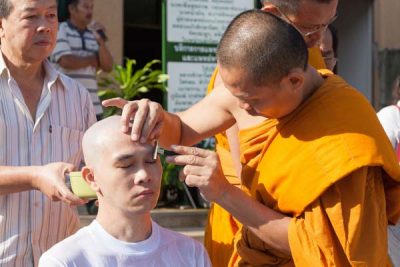
It is difficult to separate Thai culture and Buddhism, for the two are intricately woven and the religion has been the motivation for cultural expression ever since it was widely encouraged during the Sukhothai period, shortly after the founding of Chiang Mai. However, temples at Wat Doi Kham and Lampang suggest that Buddhism had taken hold in the region long before that. The art form of the many styles of Buddha is a deep study in itself and many exquisite examples of religious art can be found preserved within Chiang Mai’s ubiquitous temples.
The practice of Buddhism here has many cultural identities almost exclusively associated with Thailand and the Theravada (Hinyana – small wheel) sect of ‘old school’ Buddhism practiced in this country. Many of the mystical and mythical aspects of everyday Thai dhamma (Buddhist practice) have their roots in Hinduism, such as the symbolic characters and habits within the religion. Thais, young and old, can frequently be seen offering a quick wai of respect to Buddhist symbols such as chedis, Buddhas, monk statues and spirit houses.
Visitors will perhaps find curiosity in the small, ornately-decorated spirit houses that are seated on plinths beside buildings everywhere. These are built as residence offerings for the spirits that may occupy the area, and are important for avoiding any negative influence from a displeased spirit. They demonstrate the widespread Thai belief in making merit with the many spirits that are intertwined with their Buddhist beliefs. Likewise, they place superstitious importance on wearing amulets acquired from revered temples.
Thai people across the nation make frequent temple visits, offering food, incense sticks, lotus flowers and money to make merit. Supporting the temple and monks is important for receiving fortuitous blessings for everything from a new motorbike to a business venture. It is traditional for all young men to spend a month (at least) in the temple as a novice monk, and monks are invited to preside over most ceremonies.
Thailand is 543 years into the future, 2013 for the West is 2556 for Thais, who reckon their calendar from the Birth of the Buddha in the 4th century BC. Perhaps it’s the reason everything here moves at a more retiring pace. Thais also have their own numerals, which are seldom used these days other than to hide the fact that they are pricing something cheaper for locals.
More than 90 per cent of Thais are Buddhist, making it the largest Buddhist population in the world. The proliferation of temples and Buddhas across Thailand demonstrates how important the religion features in everyday life. Modern urban Thais may well seem indifferent to pious practice of Buddhist traditions and ceremonies; however, Buddhism continues to play a significant role in most facets of life in Thailand, from the Royal family right down to the humblest farmer. Even the Thai calendar is reckoned from the time of Gautama Buddha, 543 years before Christ.
Buddhism (a quick introduction)
With its locus in Asia, Buddhism was founded about 2,500 years ago upon the teachings of an Indian prince, Siddharta Gautama; otherwise known as the Buddha (enlightened one). After years of meditation and austere wandering in search of truth he eventually achieved a state of ‘nirvana’ through strict emptying of his mind using meditation techniques. In such a state, one finally, and wholly, lets go of all desire and thus any suffering arising from it. Part of this truth was the concept of impermanence (annica), and Buddhists believe that their ‘souls’ are continually trapped in a cycle of re-incarnation or rebirth, which they strive to break.
Central to understanding Buddhist doctrine is the recognition of suffering (known as dukkha) and out of this arises the Four Noble Truths:
- That there is suffering
- That suffering is impermanent and will eventually cease
- That suffering is a consequence of desire, usually created by ourselves
- That suffering can be brought to an end through practising of the dhamma
The dhamma, or ‘Buddhist life’, encourages the Eightfold Path of right understanding, thought, speech, conduct, livelihood, effort, attention and concentration, towards reducing or eliminating suffering.
Unlike Christianity, Buddhism doesn’t focus entirely on a supreme creator, but rather places emphasis on living in the present moment and upholding a number of precepts which are quite similar to the Ten Commandments. In practice, many modern Thais tend to lose sight of the pure teachings and motivations of Buddhism and habitually follow the rituals. ‘Church’ isn’t attended weekly but rather private trips are made to the temple regularly, as Thais place a lot of believe in merit making and appeasing of spirits. However, as with other religions, the Temple plays an important role in the Sangha (community), providing moral judgement, support and welfare, and sometimes even education and officialdom.
Around about the time of Christ, there was a great schism in Buddhism, splitting the religion into two distinctive practices. The Therevada Buddhism, which is largely practised in Thailand and the rest of Southeast Asia belongs to the Hinyana (lesser wheel) sect, which observes the original, pure form. The Mahanyana (greater wheel) sect is a reformed style of Buddhism which has resulted in the Zen Buddhism practiced predominantly in Japan and the four sects of Tibetan Buddhism, some of which are being popularised in the West.
